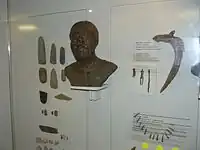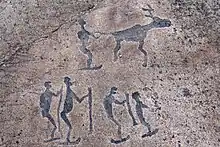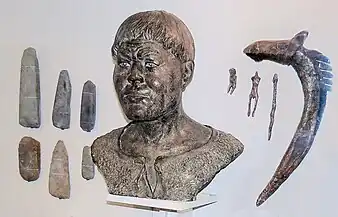Artifacts and forensic reconstruction of an Eastern Hunter-Gatherer from the site of Yuzhny Oleny island (dated c. 8,100 BP), by M.M. Gerasimov. National Museum of Karelia.[1] Hunter-gatherers in Europe between 14 ka and 9 ka, with the main area of Eastern Hunter-Gatherers (EHG, ). Individual numbers correspond to calibrated sample dates.[2] |
In archaeogenetics, the term Eastern Hunter-Gatherer (EHG), sometimes East European Hunter-Gatherer, or Eastern European Hunter-Gatherer is the name given to a distinct ancestral component that represents Mesolithic hunter-gatherers of Eastern Europe.[3]
The Eastern Hunter Gatherer genetic profile is mainly derived from Ancient North Eurasian (ANE) ancestry, which was introduced from Siberia,[4] with a secondary and smaller admixture of European Western Hunter-Gatherers (WHG).[5][6] Still, the relationship between the ANE and EHG ancestral components is not yet well understood due to lack of samples that could bridge the spatiotemporal gap.[5]
During the Mesolithic, the EHGs inhabited an area stretching from the Baltic Sea to the Urals and downwards to the Pontic–Caspian steppe.[7] Along with Scandinavian Hunter-Gatherers (SHG) and Western Hunter-Gatherers (WHG), the EHGs constituted one of the three main genetic groups in the postglacial period of early Holocene Europe.[8] The border between WHGs and EHGs ran roughly from the lower Danube, northward along the western forests of the Dnieper towards the western Baltic Sea.[9]
During the Neolithic and early Eneolithic, likely during the 4th millennium BC EHGs on the Pontic–Caspian steppe mixed with Caucasus hunter-gatherers (CHGs) with the resulting population, almost half-EHG and half-CHG, forming the genetic cluster known as Western Steppe Herder (WSH).[10][11] WSH populations closely related to the people of the Yamnaya culture are supposed to have embarked on a massive migration leading to the spread of Indo-European languages throughout large parts of Eurasia.
Research
.png.webp)
.png.webp)
Haak et al. (2015) identified the Eastern Hunter-Gatherers (EHG) as a distinct genetic cluster in two males only. The EHG male of Samara (dated to ca. 5650-5550 BC) carried Y-haplogroup R1b1a1a* and mt-haplogroup U5a1d. The other EHG male, buried in Karelia (dated to ca. 5500-5000 BC) carried Y-haplogroup R1a1 and mt-haplogoup C1g. The authors of the study also identified a Western Hunter-Gatherer (WHG) cluster and a Scandinavian Hunter-Gatherer (SHG) cluster, intermediate between WHG and EHG.[lower-alpha 1] They suggested that EHGs harbored mixed ancestry from Ancient North Eurasians (ANEs) and WHGs.[13]
Researchers have proposed various admixture proportion models for EHGs from WHGs and ANEs. [14][15] Posth et al. (2023) found that most EHG individuals carried 70% ANE ancestry and 30% WHG ancestry, while Allentoft et al. (2024) estimated roughly 58% ANE ancestry.[2][16] The high contribution from Ancient North Eurasians is also visible in a subtle affinity of the EHG to the 40,000-year-old Tianyuan man from Northern China, which can be explained by geneflow from a Tianyuan-related source into the ANE lineage (represented by Malta and Afontova Gora 3), which later substantially contributed to the formation of the EHG.[17] The 'Basal East Asian' (Tianyuan-like) ancestry among EHGs (Sidelkino) has been estimated to be around 12,9%.[18]
The formation of the EHG ancestral component is estimated to have happened 13,000–15,000 years BP.[16]
EHGs may have mixed with "an Armenian-like Near Eastern source", which formed the Yamnaya culture, as early as the Eneolithic (5200-4000 BC).[19] The people of the Yamnaya culture were found to be a mix of EHG and a "Near Eastern related population". During the 3rd millennium BC, the Yamnaya people embarked on a massive expansion throughout Europe, which significantly altered the genetic landscape of the continent. The expansion gave rise to cultures such as Corded Ware, and was possibly the source of the distribution of Indo-European languages in Europe.[13]
The people of the Mesolithic Kunda culture and the Narva culture of the eastern Baltic were a mix of WHG and EHG, showing the closest affinity with WHG. Samples from the Ukrainian Mesolithic and Neolithic were found to cluster tightly together between WHG and EHG, suggesting genetic continuity in the Dnieper Rapids for a period of 4,000 years. The Ukrainian samples belonged exclusively to the maternal haplogroup U, which is found in around 80% of all European hunter-gatherer samples.[20]
The people of the Pit–Comb Ware culture (PCW/CCC) of the eastern Baltic bear 65% EHG ancestry. This is in contrast to earlier hunter-gatherers in the area, who were more closely related to WHG. This was demonstrated using a sample of Y-DNA extracted from a Pit–Comb Ware individual. This belonged to R1a15-YP172. The four samples of mtDNA extracted constituted two samples of U5b1d1, one sample of U5a2d, and one sample of U4a.[21]
Günther et al. (2018) analyzed 13 SHGs and found all of them to be of EHG ancestry. Generally, SHGs from western and northern Scandinavia had more EHG ancestry (ca 49%) than individuals from eastern Scandinavia (ca. 38%). The authors suggested that the SHGs were a mix of WHGs who had migrated into Scandinavia from the south, and EHGs who had later migrated into Scandinavia from the northeast along the Norwegian coast. SHGs displayed higher frequences of genetic variants that cause light skin (SLC45A2 and SLC24A5), and light eyes (OCA/Herc2), than WHGs and EHGs.[22]


Members of the Kunda culture and Narva culture were also found to be more closely related with WHG, while the Pit–Comb Ware culture was more closely related to EHG. Northern and eastern areas of the eastern Baltic were found to be more closely related to EHG than southern areas. The study noted that EHGs, like SHGs and Baltic hunter-gatherers, carried high frequencies of the derived alleles for SLC24A5 and SLC45A2, which are codings for light skin.[24]
Mathieson et al. (2018) analyzed the genetics of a large number of skeletons of prehistoric Eastern Europe. Thirty-seven samples were from Mesolithic and Neolithic Ukraine (9500-6000 BC). These were classified as intermediate between EHG and SHG. The males belonged exclusively to R haplotypes (particularly subclades of R1b1 and R1a) and I haplotypes (particularly subclades of I2). Mitochondrial DNA belonged almost exclusively to U (particularly subclades of U5 and U4).[19]
A large number of individuals from the Zvejnieki burial ground, which mostly belonged to the Kunda culture and Narva culture in the eastern Baltic, were analyzed. These individuals were mostly of WHG descent in the earlier phases, but over time EHG ancestry became predominant. The Y-DNA of this site belonged almost exclusively to haplotypes of haplogroup R1b1a1a and I2a1. The mtDNA belonged exclusively to haplogroup U (particularly subclades of U2, U4 and U5).[19]
Forty individuals from three sites of the Iron Gates Mesolithic in the Balkans were estimated to be of 85% WHG and 15% EHG descent. The males at these sites carried exclusively R1b1a and I (mostly subclades of I2a) haplotypes. mtDNA belonged mostly to U (particularly subclades of U5 and U4).[19]
People of the Cucuteni–Trypillia culture were found to harbor about 20% hunter-gatherer ancestry, which was intermediate between EHG and WHG.[19]
Narasimshan et al. (2019) coined a new ancestral component, West Siberian Hunter-Gatherer (WSHG). WSHGs contained about 20% EHG ancestry, 73% ANE ancestry, and 6% East Asian ancestry.[25]
Possible association with Early Indo-European
The EHG have been argued by some to represent a possible source for the Pre-Proto-Indo-European language (see also Father Tongue hypothesis). Unlike the Yamnaya culture people (or closely related groups), which are associated with speakers of Proto-Indo-European, the EHG-rich Dnieper–Donets culture people show no evidence of Caucasus Hunter-Gatherer (CHG) or Early European Farmer (EEF) ancestry.[26] Both Dnieper-Donets males and Yamnaya males carry the same paternal haplogroups (R1b and I2a), suggesting that the CHG and EEF admixture among the Yamnaya came through EHG males mixing with EEF and CHG females. Based on this, David W. Anthony, this suggests that the Indo-European languages were initially spoken by EHGs living in Eastern Europe.[27]
Others have suggested that the Indo-European language family may have originated not in Eastern Europe, but among CHG-rich West Asian populations South of the Caucasus which later absorbed EHG-rich groups North of the Caucasus. It was noted that haplogroups may not correlate with autosomal ancestry components and historical language dispersals.[28]
Physical appearance
.png.webp)
The EHGs are suggested to have had mostly brown eyes and light skin,[22][30] with "intermediate frequencies of the blue-eye variants" and "high frequencies of the light-skin variants."[31] An EHG from Karelia was determined by Günther (2018) to have high probabilities of being brown-eyed and dark haired, with a predicted intermediate skin tone.[32] Another EHG from Samara was predicted to be light skinned, and was determined to have a high probability of being blue-eyed with a light hair shade, with a 75% calculated probability of being blond-haired.[33][31]
The rs12821256 allele of the KITLG gene that controls melanocyte development and melanin synthesis,[34] which is associated with blond hair and first found in an individual from Siberia dated to around 17,000 BP, is found in three Eastern Hunter-Gatherers from Samara, Motala and Ukraine c. 10,000 BP, suggesting that this allele originated in the Ancient North Eurasian population, before spreading to western Eurasia.[35]
Many remains of East Hunter-Gatherers dated to circa 8,100 BP (6,100 BCE) have also been excavated at Yuzhny Oleny island in Lake Onega.[36] The Ancient North Eurasian (ANE) ancestry is by far the main component of the Yuzhny Oleny group, and is among the highest within the rest of the Eastern Hunter-Gatherers (EHG).[4]
 Reconstruction of burial No. 132 of the Oleneostrovsky burial ground (Yuzhni Oleny island, Lake Onega). Exhibit of the National Museum of the Republic of Karelia.[37]
Reconstruction of burial No. 132 of the Oleneostrovsky burial ground (Yuzhni Oleny island, Lake Onega). Exhibit of the National Museum of the Republic of Karelia.[37] Artifacts and reconstruction of Eastern Hunter-Gatherers from Yuzhny Oleny island by Gerasimov.[37]
Artifacts and reconstruction of Eastern Hunter-Gatherers from Yuzhny Oleny island by Gerasimov.[37] Karelian Petroglyph depicting 5 skiers and a reindeer. These petroglyphs date to 7,000~6,000 years BP.
Karelian Petroglyph depicting 5 skiers and a reindeer. These petroglyphs date to 7,000~6,000 years BP.
Material culture
.jpg.webp)
As hunter-gatherers, the EHGs initially relied on stone tools and artifacts derived from ivory, horns or antlers. From circa 5,900 BC, they started to adopt pottery in the area of the northern Caspian Sea, or possibly from beyond the Ural. In barely three or four centuries, pottery spread over a distance of about 3,000 kilometers, reaching as far as the Baltic sea. This technological spread was much faster than the spread of agriculture itself, and mainly occurred through technology transfer between hunter-gatherer groups, rather than through the demic diffusion of agriculturalist.[39]
See also
Notes
References
- ↑ National Museum of Karelia exhibit
- 1 2 Posth, Cosimo; Yu, He; Ghalichi, Ayshin (March 2023). "Palaeogenomics of Upper Palaeolithic to Neolithic European hunter-gatherers". Nature. 615 (7950): 117–126. Bibcode:2023Natur.615..117P. doi:10.1038/s41586-023-05726-0. ISSN 1476-4687. PMC 9977688. PMID 36859578.
- ↑ Haak, Wolfgang; Lazaridis, Iosif; Patterson, Nick; Rohland, Nadin; Mallick, Swapan; Llamas, Bastien; Brandt, Guido; Nordenfelt, Susanne; Harney, Eadaoin; Stewardson, Kristin; Fu, Qiaomei (2015-06-01). "Massive migration from the steppe was a source for Indo-European languages in Europe". Nature. 522 (7555): 207–211. doi:10.1038/nature14317. ISSN 1476-4687. PMC 5048219. PMID 25731166.
- 1 2 Kozintsev, A. G. (4 January 2022). "Patterns in the Population History of Northern Eurasia from the Mesolithic to the Early Bronze Age, Based on Craniometry and Genetics". Archaeology, Ethnology & Anthropology of Eurasia. 49 (4): 141. doi:10.17746/1563-0110.2021.49.4.140-151.
ANE makes up the principal share of the EHG (Eastern Hunter-Gatherer) autosomal component, whose content is especially high in the genomes of Mesolithic and Early Neolithic inhabitants of northeastern Europe buried at Yuzhny Oleny Ostrov, Popovo, Sidelkino, Lebyazhinka IV, etc. (Haak et al., 2015; Damgaard et al., 2018). They passed EHG on to the Yamnaya people, from whom it was inherited by several filial populations, including Afanasyevans. As early as the Mesolithic, EHG was introduced from northern Russia to Scandinavia, as evidenced by genomes of the Motala people in southern Sweden. Their ancestors had migrated there from the east along the coast of Norway, because the share of EHG in more southern populations, such as the earlier Kunda people of the eastern Baltic, is lower (Haak et al., 2015; Mittnik et al., 2018).
- 1 2 Feldman, Michal; Gnecchi-Ruscone, Guido A.; Lamnidis, Thiseas C.; Posth, Cosimo (2021). "Where Asia meets Europe – recent insights from ancient human genomics". Annals of Human Biology. 48 (3): 191–202. doi:10.1080/03014460.2021.1949039. PMID 34459345. S2CID 237348859.
- ↑ Nägele, Kathrin; Rivollat, Maite; Yu, He; Wang, Ke (2022). "Ancient genomic research - From broad strokes to nuanced reconstructions of the past". Journal of Anthropological Sciences. 100 (100): 193–230. doi:10.4436/jass.10017. PMID 36576953.
- ↑ Anthony 2019b, p. 27.
- ↑ Kashuba 2019: "Earlier aDNA studies suggest the presence of three genetic groups in early postglacial Europe: Western hunter–gatherers (WHG), Eastern hunter–gatherers (EHG), and Scandinavian hunter–gatherers (SHG)4. The SHG have been modelled as a mixture of WHG and EHG."
- ↑ Anthony 2019b, p. 28.
- ↑ Haak, Wolfgang; Lazaridis, Iosif; Patterson, Nick; Rohland, Nadin; Mallick, Swapan; Llamas, Bastien; Brandt, Guido; Nordenfelt, Susanne; Harney, Eadaoin; Stewardson, Kristin; Fu, Qiaomei (2015-06-01). "Massive migration from the steppe was a source for Indo-European languages in Europe". Nature. 522 (7555): 207–211. arXiv:1502.02783. Bibcode:2015Natur.522..207H. doi:10.1038/nature14317. ISSN 1476-4687. PMC 5048219. PMID 25731166.
- ↑ Lazaridis, Iosif; Alpaslan-Roodenberg, Songül; Acar, Ayşe; Açıkkol, Ayşen; Agelarakis, Anagnostis; Aghikyan, Levon; Akyüz, Uğur; Andreeva, Desislava; Andrijašević, Gojko; Antonović, Dragana; Armit, Ian; Atmaca, Alper; Avetisyan, Pavel; Aytek, Ahmet İhsan; Bacvarov, Krum (2022-08-26). "The genetic history of the Southern Arc: A bridge between West Asia and Europe". Science. 377 (6609): eabm4247. doi:10.1126/science.abm4247. ISSN 0036-8075. PMC 10064553. PMID 36007055. S2CID 251843620.
- ↑ Lazaridis 2016.
- 1 2 Haak 2015.
- ↑ Lazaridis, Iosif (2018-12-01). "The evolutionary history of human populations in Europe". Current Opinion in Genetics & Development. Genetics of Human Origins. 53: 21–27. arXiv:1805.01579. doi:10.1016/j.gde.2018.06.007. ISSN 0959-437X. PMID 29960127. S2CID 19158377.
- ↑ Haak, Wolfgang; Lazaridis, Iosif; Patterson, Nick; Rohland, Nadin; Mallick, Swapan; Llamas, Bastien; Brandt, Guido; Nordenfelt, Susanne; Harney, Eadaoin; Stewardson, Kristin; Fu, Qiaomei; Mittnik, Alissa; Bánffy, Eszter; Economou, Christos; Francken, Michael (June 2015). "Massive migration from the steppe was a source for Indo-European languages in Europe". Nature. 522 (7555): 207–211. arXiv:1502.02783. Bibcode:2015Natur.522..207H. doi:10.1038/nature14317. ISSN 1476-4687. PMC 5048219. PMID 25731166.
Haak et al. (2015): 38–40% ANE (MA-1), 60–62% WHG (Fig S8.6). (Alternative topologies where EHG and ANE are unadmixed sister lineages, with WHG being admixed, are not rejected)
- 1 2 Allentoft, Morten E.; Sikora, Martin; Refoyo-Martínez, Alba; Irving-Pease, Evan K.; Fischer, Anders; Barrie, William; Ingason, Andrés; Stenderup, Jesper; Sjögren, Karl-Göran; Pearson, Alice; Sousa da Mota, Bárbara; Schulz Paulsson, Bettina; Halgren, Alma; Macleod, Ruairidh; Jørkov, Marie Louise Schjellerup (January 2024). "Population genomics of post-glacial western Eurasia". Nature. 625 (7994): 301–311. doi:10.1038/s41586-023-06865-0. ISSN 1476-4687. PMC 10781627. PMID 38200295.
- ↑ Villalba-Mouco, Vanessa; van de Loosdrecht, Marieke S.; Rohrlach, Adam B.; Fewlass, Helen; Talamo, Sahra; Yu, He; Aron, Franziska; Lalueza-Fox, Carles; Cabello, Lidia; Cantalejo Duarte, Pedro; Ramos-Muñoz, José; Posth, Cosimo; Krause, Johannes; Weniger, Gerd-Christian; Haak, Wolfgang (April 2023). "A 23,000-year-old southern Iberian individual links human groups that lived in Western Europe before and after the Last Glacial Maximum". Nature Ecology & Evolution. 7 (4): 597–609. Bibcode:2023NatEE...7..597V. doi:10.1038/s41559-023-01987-0. ISSN 2397-334X. PMC 10089921. PMID 36859553.
Currently, the strongest affinity to Tianyuan in Holocene European HGs was reported for Eastern European HGs (EHG). This is because the ancestry found in Mal'ta and Afontova Gora individuals (Ancient North Eurasian ancestry) received ancestry from UP East Asian/Southeast Asian populations54, who then contributed substantially to EHG55.
- ↑ Childebayeva, Ainash; et al. (October 1, 2023). "Bronze Age Northern Eurasian Genetics in the Context of Development of Metallurgy and Siberian Ancestry". BioRxiv: Figure 6. doi:10.1101/2023.10.01.560195. S2CID 263672903.
- 1 2 3 4 5 Mathieson et al. 2018.
- ↑ Jones 2017.
- ↑ Saag 2017.
- 1 2 Günther 2018.
- ↑ Zhang, Fan; Ning, Chao; Scott, Ashley (November 2021). "The genomic origins of the Bronze Age Tarim Basin mummies". Nature. 599 (7884): 256–261. Bibcode:2021Natur.599..256Z. doi:10.1038/s41586-021-04052-7. ISSN 1476-4687. PMC 8580821. PMID 34707286.
- ↑ Mittnik 2018.
- ↑ Narasimhan 2019.
- ↑ Anthony 2019a, p. 14.
- ↑ Anthony 2019a, pp. 7, 14.
- ↑ Lazaridis, Iosif; Alpaslan-Roodenberg, Songül; Acar, Ayşe; Açıkkol, Ayşen; Agelarakis, Anagnostis; Aghikyan, Levon; Akyüz, Uğur; Andreeva, Desislava; Andrijašević, Gojko; Antonović, Dragana; Armit, Ian; Atmaca, Alper; Avetisyan, Pavel; Aytek, Ahmet İhsan; Bacvarov, Krum (2022-08-26). "The genetic history of the Southern Arc: A bridge between West Asia and Europe". Science. 377 (6609): eabm4247. doi:10.1126/science.abm4247. ISSN 0036-8075. PMC 10064553. PMID 36007055.
- ↑ Hanel, Andrea; Carlberg, Carsten (3 July 2020). "Skin colour and vitamin D: An update". Experimental Dermatology. 29 (9): 864–875. doi:10.1111/exd.14142. PMID 32621306. S2CID 220335539.
- ↑ Hanel, Andrea; Carlberg, Carsten (2020). "Skin Colour and Vitamin D: An update". Experimental Dermatology. 29 (9): 864–875. doi:10.1111/exd.14142. PMID 32621306. S2CID 220335539. "Interestingly, eastern and Scandinavian hunter-gatherers had light skin,[48] in contrast to Baltic hunter-gatherers who kept their dark skin only until 3800 years ago when farming was introduced in this region by the Bronze Age expansion of people of Russian steppe origin.[56, 57]"
- 1 2 Population genomics of Mesolithic Scandinavia: Investigating early postglacial migration routes and high-latitude adaptation S8 Text. Functional variation in ancient samples., doi:10.1371/journal.pbio.2003703.s013
- ↑ Günther 2018, p. 4/28: From Supplementary document S8: "The Karelian individual presents high probabilities of being brown-eyed (0.99), and having a dark hair (0.96). Without speculating about the genetic architecture of skin pigmentation, we suggest an intermediate skin-pigmentation phenotype for the Karelia individual, as it carried the ancestral allele at rs16891982 and the derived allele at rs1426654 (S1 Table). The presence of the rs1426654 light-skin allele, in addition to five additional C11-associated alleles at haplotype defining SNPs (S1 Table) suggests that the Karelian individual carried the C11 light-skin haplotype."
- ↑ Günther 2018, p. 4/28: From Supplementary document S8: "The Samaran individual exhibits high probabilities of being blue-eyed (0.88), light hair shade (0.99); most likely being blond (0.75)."
- ↑ Sulem, Patrick; Gudbjartsson, Daniel F.; Stacey, Simon N.; Helgason, Agnar; Rafnar, Thorunn; Magnusson, Kristinn P.; Manolescu, Andrei; Karason, Ari; Palsson, Arnar; Thorleifsson, Gudmar; et al. (December 2007). "Genetic determinants of hair, eye and skin pigmentation in Europeans". Nature Genetics. 39 (12): 1443–1452. doi:10.1038/ng.2007.13. ISSN 1546-1718. PMID 17952075. S2CID 19313549.
- ↑ Mathieson et al. 2018 "Supplementary Information page 52: "The derived allele of the KITLG SNP rs12821256 that is associated with – and likely causal for blond hair in Europeans is present in one hunter-gatherer from each of Samara, Motala and Ukraine (I0124, I0014 and I1763), as well as several later individuals with Steppe ancestry. Since the allele is found in populations with EHG but not WHG ancestry, it suggests that its origin is in the Ancient North Eurasian (ANE) population. Consistent with this, we observe that the earliest known individual with the derived allele (supported by two reads) is the ANE individual Afontova Gora 3, which is directly dated to 16130-15749 cal BCE (14710±60 BP, MAMS-27186: a previously unpublished date that we newly report here). We cannot determine the status of rs12821256 in Afontova Gora 2 and MA-1 due to lack of sequence coverage at this SNP."
- ↑ Mittnik, Alissa; Wang, Chuan-Chao; Pfrengle, Saskia (30 January 2018). "The genetic prehistory of the Baltic Sea region". Nature Communications. 9 (1): Fig. 1. Bibcode:2018NatCo...9..442M. doi:10.1038/s41467-018-02825-9. ISSN 2041-1723. PMC 5789860. PMID 29382937.
- 1 2 Kozintsev, Alexander (1 January 2021). "Patterns in the population history of Northern Eurasia from the Mesolithic to the Early Bronze Age". Archaeology, Ethnology and Anthropology of Eurasia. 49 (4): 140–151. doi:10.17746/1563-0110.2021.49.4.140-151.
ANE makes up the principal share of the EHG (Eastern Hunter-Gatherer) autosomal component, whose content is especially high in the genomes of Mesolithic and Early Neolithic inhabitants of northeastern Europe buried at Yuzhny Oleny Ostrov, Popovo, Sidelkino, Lebyazhinka IV, etc. (Haak et al., 2015; Damgaard et al., 2018).", "Mesolithic, northern Russian Plain, Yuzhny Oleny Ostrov (Alekseyev, Gokhman, 1984)
- ↑ Dolbunova, Ekaterina; Lucquin, Alexandre (February 2023). "The transmission of pottery technology among prehistoric European hunter-gatherers". Nature Human Behaviour. 7 (2): 171–183. doi:10.1038/s41562-022-01491-8. ISSN 2397-3374. PMC 9957732. PMID 36550220.
- ↑ Dolbunova, Ekaterina; Lucquin, Alexandre (February 2023). "The transmission of pottery technology among prehistoric European hunter-gatherers". Nature Human Behaviour. 7 (2): 171–183. doi:10.1038/s41562-022-01491-8. ISSN 2397-3374. PMC 9957732. PMID 36550220.
Although demic diffusion may have a role, on the basis of its speed we argue that pottery production was rapidly disseminated through knowledge transfer across established networks between dispersed hunter-gatherer communities
Bibliography
- Anthony, David (Spring–Summer 2019a). "Archaeology, Genetics, and Language in the Steppes: A Comment on Bomhard". Journal of Indo-European Studies. 47 (1–2). Retrieved January 9, 2020.
- Anthony, David W. (2019b). "Ancient DNA, Mating Networks, and the Anatolian Split". In Serangeli, Matilde; Olander, Thomas (eds.). Dispersals and Diversification: Linguistic and Archaeological Perspectives on the Early Stages of Indo-European. BRILL. pp. 21–54. ISBN 978-9004416192.
- Günther, Thorsten (January 1, 2018). "Population genomics of Mesolithic Scandinavia: Investigating early postglacial migration routes and high-latitude adaptation". PLOS Biology. PLOS. 16 (1): e2003703. doi:10.1371/journal.pbio.2003703. PMC 5760011. PMID 29315301.
- Haak, Wolfgang (June 11, 2015). "Massive migration from the steppe was a source for Indo-European languages in Europe". Nature. 522 (7555): 207–211. arXiv:1502.02783. Bibcode:2015Natur.522..207H. doi:10.1038/nature14317. PMC 5048219. PMID 25731166.
- Jones, Eppie R. (February 20, 2017). "The Neolithic Transition in the Baltic Was Not Driven by Admixture with Early European Farmers". Current Biology. Cell Press. 27 (4): 576–582. doi:10.1016/j.cub.2016.12.060. PMC 5321670. PMID 28162894.
- Kashuba, Natalija (May 15, 2019). "Ancient DNA from mastics solidifies connection between material culture and genetics of mesolithic hunter–gatherers in Scandinavia". Communications Biology. Nature Research. 2 (105): 185. doi:10.1038/s42003-019-0399-1. PMC 6520363. PMID 31123709.
- Lazaridis, Iosif (July 25, 2016). "Genomic insights into the origin of farming in the ancient Near East". Nature. 536 (7617): 419–424. Bibcode:2016Natur.536..419L. doi:10.1038/nature19310. PMC 5003663. PMID 27459054.
- Mathieson, Iain (November 23, 2015). "Genome-wide patterns of selection in 230 ancient Eurasians". Nature. 528 (7583): 499–503. Bibcode:2015Natur.528..499M. doi:10.1038/nature16152. PMC 4918750. PMID 26595274.
- Mathieson, Iain; Alpaslan-Roodenberg, Songül; Posth, Cosimo; Szécsényi-Nagy, Anna; et al. (March 2018). "The genomic history of southeastern Europe". Nature. 555 (7695): 197–203. Bibcode:2018Natur.555..197M. doi:10.1038/nature25778. PMC 6091220. PMID 29466330.
- Mittnik, Alisa (January 30, 2018). "The genetic prehistory of the Baltic Sea region". Nature Communications. 16 (1): 442. Bibcode:2018NatCo...9..442M. doi:10.1038/s41467-018-02825-9. PMC 5789860. PMID 29382937.
- Narasimhan, Vagheesh M. (September 6, 2019). "The formation of human populations in South and Central Asia". Science. American Association for the Advancement of Science. 365 (6457): eaat7487. bioRxiv 10.1101/292581. doi:10.1126/science.aat7487. PMC 6822619. PMID 31488661.
- Saag, Lehti (July 24, 2017). "Extensive Farming in Estonia Started through a Sex-Biased Migration from the Steppe". Current Biology. Cell Press. 27 (14): 2185–2193. doi:10.1016/j.cub.2017.06.022. PMID 28712569.
- Wang, Chuan-Chao (February 4, 2019). "Ancient human genome-wide data from a 3000-year interval in the Caucasus corresponds with eco-geographic regions Eurasia". Nature Communications. 10 (1): 590. Bibcode:2019NatCo..10..590W. doi:10.1038/s41467-018-08220-8. PMC 6360191. PMID 30713341.
Further reading
- Anthony, David (Spring–Summer 2019). "Archaeology, Genetics, and Language in the Steppes: A Comment on Bomhard". Journal of Indo-European Studies. 47 (1–2). Retrieved January 9, 2020.
- Anthony, David W. (2019b). "Ancient DNA, Mating Networks, and the Anatolian Split". In Serangeli, Matilde; Olander, Thomas (eds.). Dispersals and Diversification: Linguistic and Archaeological Perspectives on the Early Stages of Indo-European. BRILL. pp. 21–54. ISBN 978-9004416192.
- Allentoft, Morten E.; Sikora, Martin; Sjögren, Karl-Göran; Rasmussen, Simon; Rasmussen, Morten; Stenderup, Jesper; Damgaard, Peter B.; Schroeder, Hannes; Ahlström, Torbjörn; Vinner, Lasse; Malaspinas, Anna-Sapfo (2015). "Population genomics of Bronze Age Eurasia". Nature. 522 (7555): 167–172. Bibcode:2015Natur.522..167A. doi:10.1038/nature14507. ISSN 1476-4687. PMID 26062507. S2CID 4399103.
- Lazaridis, Iosif (December 2018). "The evolutionary history of human populations in Europe". Current Opinion in Genetics & Development. Elsevier. 53: 21–27. arXiv:1805.01579. doi:10.1016/j.gde.2018.06.007. PMID 29960127. S2CID 19158377. Retrieved July 15, 2020.

.png.webp)